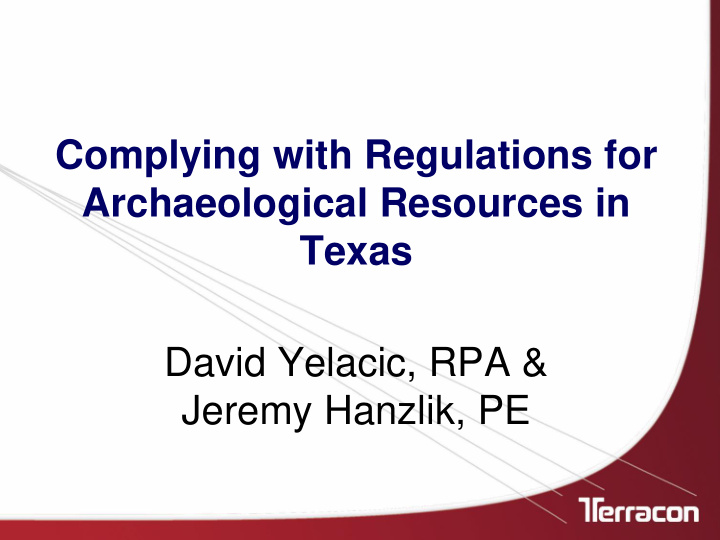



Complying with Regulations for Archaeological Resources in Texas David Yelacic, RPA & Jeremy Hanzlik, PE
Learning Objectives At the end of the this course, participants will be able to: 1. understand the regulatory context of cultural resources and the nuances of overlapping jurisdictions (City, State, Federal, etc.); 2. recognize SAL, NRHP, and UNESCO World Heritage designations, as well as implications for project development; 3. understand the historic context of Spanish Missions in Texas and their impact on the landscape; 4. apply knowledge of the cultural resources and regulatory processes from this case study to their own projects.
Background and Introduction • Regulatory Context • NHPA • The Code • UDC • Redevelopment of St. John’s Anthro and Geography Texas State University Senior Project Archaeologist, Principal Investigator Terracon Consultants, Inc.
San Andres San Esteban Espiritu Santo Santa Maria de Yciar 1554
Department of the Interior and Smithsonian Institution i.e., Bureau of American Ethnology, 1879
Bull Run Battlefield, VA War Department
Antiquities Act of 1906 prohibiting excavation of antiquities on public land Depression Era Historic Sites Act, 1935 historians, architects, beginning of register for National Historic Landmarks field archaeologists, etc.
National Historic Preservation Act of 1966 – ACHP and SHPOs – National Register of Historic Places – Section 106 (36 CFR 800) • Requirement that agencies consider the effects of their actions on properties eligible for or included in the National Register of Historic Places…
The Antiquities Code of Texas Established in 1969 in direct response to private, out-of-state salvage operation on 1554 shipwrecks Gives Texas Antiquities Committee/Texas Historical Commission jurisdiction over cultural resources on state- owned lands
. . . to locate, protect, and preserve all sites, objects, buildings, pre-twentieth century shipwrecks, and locations of historical, archaeological, educational or scientific interest . . . (Natural Resources Code Title 9, Chapter 191)
Political subdivisions of the State and other local government agencies must notify the THC prior to commencing any project on state land that will involve 5+ acres of ground disturbance, 5,000 cubic yards, historic districts, or recorded sites. State agencies, including public universities, must notify the THC prior to breaking ground on state Protection of most significant sites land.
UNESCO World Heritage (1972) Seeks to encourage the identification, protection, and preservation of cultural and natural heritage around the world considered to be of outstanding value to humanity.
Unified Development Code • Historic Design and Review Commission • Office of Historic Preservation – City Archaeologist – Assistant City Archaeologist Mission Espada Acequia
Cultural Resources Aspects of the human environment that have cultural value to a group of people . . .
What do CR practitioners do? Consultation/coordination – Conversations with regulators – Desktop reviews, assessments, etc. Compliance – Assessments, fieldwork, etc. – Permits? – Recommendations
Desktop Review/Assessment To initiate consultation with SHPO or to provide a site constraints analysis • Protected (restricted access) data – Texas Archeological Sites Atlas • Historical/Archival Information – Topographic maps, Bird’s Eye maps, Sanborn Maps etc. – Deed records – Other sources? • Physical landscape – Soil surveys – Geological Surveys
• Footprint of city expanding • Hotel invasion • Artifacts of mapping?
Fieldwork: Surveys and more • Standardized methodology – Including assessment/preparation • Area of Potential Effect (APE) • Data collection (i.e., sampling) – Shovel tests – Sites – Geography – Context
Testing and Mitigation • Is the site/structure eligible for NRHP? • Can adverse impacts be avoided? • Scope coordinated with regulators
St. John’s Redevelopment
Working Parameters • Designations • Regulatory obligations – Local Historic – UDC Marker/District – Antiquities Code – SAL – Standard 8 of SOI for – NRHP, NHL Rehabilitation Incentives – World Heritage
Initial Research
Ground Penetrating Radar
Intensive Survey
Pajalache/Concepcíon Acequia
Data Recovery Many of the same types of artifacts as previously found PLUS mission-era Guerrero points
Yet to be completed . . . • Further excavations and archaeological monitoring • Interpretation of mission-related elements • Robust analysis and reporting
Summary Section 106 of the National Historic Preservation Act requires consideration of impacts to cultural resources when there is a federal nexus. The Antiquities Code of Texas requires the assessment of impacts of development on cultural resources on state (and local government) property. The Texas Historical Commission is the legal custodian of the Antiquities Code and consults in 106 as SHPO. UDC is another level of regulation in San Antonio ETJ. CR practitioners (i.e., archaeologists, historians, architects, etc.) manage public and private projects through compliance
Questions? David Yelacic, RPA david.yelacic@terracon.com (210) 714-2131 Jeremy Hanzlik, PE jeremy.hanzlik@terracon.com (210) 714-2146
Recommend
More recommend